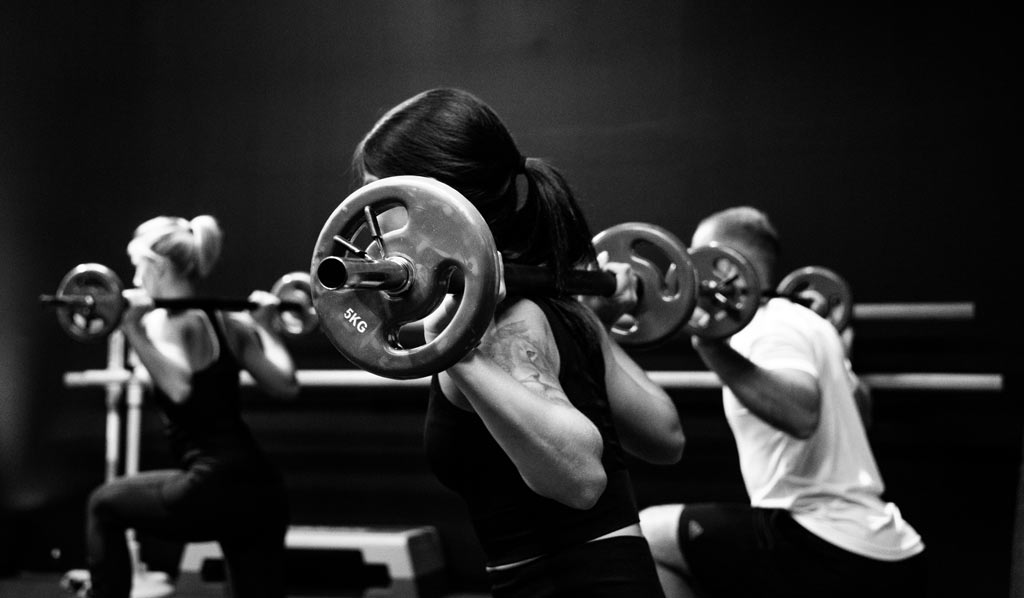Is mixing cardio and weight training in one workout beneficial?
YES! Mixing weight training and cardio into one is called metabolic resistance training, and it’s an effective, efficient and satisfying way to work out.
What is metabolic resistance training?
This post may contain affiliate links. Please see my full disclosure here.
Metabolic resistance training, also called cardio weight training, or as I like to call it, “AAAAAGGGGH!” is where you combine cardio and strength training in one work out. The result is a workout that exhausts both the muscles and the cardiovascular system. Sometimes the workout is filled with exercises that combine both elements themselves, and sometimes it’s a matter of alternating cardiovascular and strength training exercises.
More traditional weightlifting schools separate strength training from cardiovascular activity, performing them in separate workouts. There might even be segments of a workout program devoted just to one or the other type of working out. While this is sometimes an effective strategy, it’s not the only strategy, and it might not be the best for what you want to achieve.
Why should you do cardio weight training?
There are lots of reasons to do cardio weight training:
- Builds muscle. There are numerous benefits to building muscle, like that it raises your metabolism (for more fat burn), helps you fight osteoporosis, reduces pain and injury, and the best one—it makes you stronger, which, it turns out, is very convenient at times.
- Burns a lot of fat. It torches fat during the workout because you’re working at a pretty high intensity. It also burns fat after the workout is done (the “afterburn effect”). How awesome is that?
- Elevates your mood. Intense exercise releases endorphins, which are these beautiful and natural happy chemicals in your brain.
- Saves time. You can get a crapload of workout done in just 30 minutes (sometimes less). Not only does this make scheduling the gym so much easier, it’s great for those of us that get really bored with long gym sessions.
- It’s fun. Yeah, it is. You go balls-out and really get to push yourself. Because you’re operating at a high intensity, you really don’t have the mind space to think about anything else. And you can make or follow a different workout each and every time, so you won’t be bored of the same ol’ workout.
- Simplifies your workout plan. When mixing cardio and weight training, you usually aren’t going for specific strength gains, but building overall muscle and burning a crapload of fat, which is what most of us want anyway. And if there are specific parts of your body you want to sculpt, you can add more exercises in for that body part or do a specific strength-focused finisher.
- Has amazing health benefits. Besides the health benefits of keeping you lean and strong, metabolic resistance training helps to stave off osteoporosis, cancer, diabetes, alzheimer’s and heart disease.
Are you convinced yet that you should be mixing cardio and weight training? Because if you’re still on the fence I’ll make it easier for you: Get on that sh*t. Like, yesterday. You should be incorporating metabolic resistance training no matter what.
Even if you’re not doing it every workout, varying up your workout routine and style will help you reach new heights in your fitness. The body is adaptive, which is incredible. But it also means that once it’s figured out how to do what you’re doing, it does it more efficiently. More efficiency equals easier workouts, equals less gains and more plateaus.
How do you do metabolic resistance training?

There are lots of ways to mix weight training and cardio, but on the whole, there are a few good rules.
Use free weights, not machines.
If you’re at a gym, the machines get complicated with people wanting to use them. Plus, they often isolate one muscle very well, which is great for training that one muscle, and bad for mixing cardio and weight training.
They also resist movement to one very strict plane of movement. Again, great for that one movement, but when the goal is using as much of the body as possible, the machines aren’t the best option.
Shorten rest periods.
Don’t wait a minute between sets. Wait 20 seconds, or even 10. Go from one exercise to the next immediately. Take a short break between workout parts, but try not to take any rest over 90 seconds. You will sometimes need a rest, which is fine. Stop, take a few breaths and move on. This is the challenge (and fun) of metabolic resistance training.
Include multiple muscle groups.
Including more of the whole body means you’re maximizing your cardiovascular benefits. There are a couple of ways to do this.
Use compound exercises.
Compound exercises use more than one muscle group or joint, either by nature of the movement (squats) or by combining exercises (like thrusters or a deadlift/high pull). Using more muscles requires more effort and more cardiovascular activity, so you’re getting strength and cardio benefits in one exercise.
You don’t need to have every exercise be a compound exercise, but pepper them throughout your workout as a framework. Most likely they’ll be some of the more challenging exercises.
Exercise the full body.
Full body workouts are the standard when mixing cardio with weight training. You just have more muscles at your disposal to get maximum cardio benefits.
But even when doing a workout split (lower body or upper body, usually), use your full body whenever possible. You can alternate weighted exercises with some full body cardio exercises, like burpees. If performing lower body exercises like squats or lunges, hold the weight up at your shoulders or against your chest to use your upper body and core. You can also try lifting your hands in the air if doing squats or jump squats, or doing bodyweight squats while performing curls.
Include plyometrics.

Plyometrics means jumping. Getting some air underneath you is the easiest and fastest way to begin mixing cardio with weight training. Not only do you get great aerobic exercise from plyometrics, you also increase the strain on the muscles, adding to your strength gains.
You can add plyometrics to bodyweight or weighted exercises. Bodyweight exercises lend themselves to plyometrics easily and naturally. Because the load on bodyweight exercises is usually lighter (not always, but most of the time), adding a jump in isn’t too much of a challenge, and you’ll be able to reach fatigue with a decent amount of reps.
Bodyweight plyometrics exercises also complement weighted exercises beautifully, by continuing to work the muscles in a different way and without adding as much stress on the joints.
If you really want to feel your heart rate shoot up, though, add plyometrics to weighted exercises. This is the queen mommy of mixing cardio and weight training, but it should be done carefully and sparingly. It is very taxing on your system, and a little bit goes a long way. Incorporate the other factors to round out a fantastic metabolic resistance training workout that succeeds in mixing cardio with weight training effectively.
Exceptions to the rules of mixing cardio and weight training.
While these four rules will make it very easy to get some great cardio and strength training out of your workout, you don’t need to do all of them. They’re just guidelines.
The easiest and fastest way to add cardio to weight training is to start jumping, but not everyone can or should do that very much, anyway. Many people have difficulty jumping, whether it’s due to inactivity, weight, injury or just neighbors downstairs. If you can’t jump because of difficulty, then let this one go.
If you can’t jump because of situational reasons, or really want to try, then just do an “almost jump.” This is where you… almost jump. You start the jump but don’t really leave the floor, resulting in a nice bounce. It’s a nice halfway point from not jumping to fully jumping, and it spares your joints—and your neighbors.
Also, you might want to do a workout of just upper body isolation exercises. If that’s the case, throw out the rest periods and see how metabolic it gets. You might find, however, that you just exhausting the muscles very quickly. If that’s the case, consider throwing in some abs to space it out, or make this just one little intense part of a fuller workout.
Likewise, if you have an entire gym with machines at your disposal, then sure, use machines if you want. You could certainly get an amazing metabolic resistance training sesh in with alternating the leg press and free weight deadlifts, for example. They don’t allow for a lot of variation of movement, so be sure to use machines in conjunction with free weights.
Good practices for mixing cardio and weight training.

You’ll know if you’re getting a good metabolic resistance training workout, trust me. The best assessment is your own, after the workout is over. I suggest taking notes in a workout journal to help with this. But here are some good practices that can guide you to putting together an amazing cardio weight training workout:
Plan your workout in advance (or follow one someone else made).
It’s hard to have an effective workout mixing cardio and strength training unless you plan it in advance. Because you need to minimize the rest times, planning a workout on the fly is a little stressful. Get a notebook or workout journal and get at least a framework going. It’s much easier to adjust reps or rounds as you get going if you need to.
Alternate bodyweight with weights.
Spacing out weighted exercises gives your muscles, joints and nervous system a chance to rest. And if you’ve already fatigued your muscles from weights, bodyweight exercises will be much more difficult than they usually are.
Thoughtfully pace out cardio and strength training.
The easiest way to do this is to evenly space out cardio exercises among the heavy weight lifting ones when mixing them together. That way, your body gets a bit of a rest from heavy lifting. You can also do small parts devoted to each. For instance, you could do a mini-circuit for the upper body, then a mini-circuit for cardio, then a mini-circuit for the lower body. Just remember to minimize rest between parts so the cardiovascular benefits carry over from one part to another.
Be mindful about the rest periods, and adjust if necessary.
There’s no exact math for this because it depends on what exercises you’re doing, how much weight, your fitness level, and so on. But if you’re doing HIIT and at the beginning of every work interval you find yourself lagging to start, your rest periods are probably too short. Changing a rest interval by five seconds can do a lot to change how intense the workout is. On the other hand, if you’re not scrambling a little bit to start each work interval then they might be too long. Same with time between workout sections: You should always be a little tired from the last section as you start a new one. Remember, we’re going for cardiovascular activity here, and that means never slowing down too much.
Consider going lighter on weights than you might for strength exercises.
When mixing cardio and strength training, you’ll likely be taxed from aerobic activity as well as from lifting, so go a little lighter than you might if you were doing reps from a fully rested state. You might also be doing a higher amount of reps, so going a tad lighter is always a good idea.
If there are specific muscles or body parts you want to build in size or strength, separate those exercises out from the rest.
Metabolic resistance training does build muscle, but it’s not the fastest way to do so. Remember, it also burns a lot of fat. What you get is an all-in-one workout plan that gets you lean and toned, but not necessarily big. This may be a great thing for you—many people just want a nice shape and the fat layer to minimize to be able to see the muscle underneath. If you’re looking to build size or strength in any muscle or muscle group, however, separate those exercises out from the pack. You can still do a metabolic resistance workout, but strength train those muscles before or after the workout.
Have fun.

The best part of cardio weight training is that it’s fun. It’s varied, it’s challenging, and it gets your happy brain chemicals going. I love the challenge of just putting together a great workout. Then it’s not just about what exercises you’re doing, but how to structure the workout and what combinations you’re doing.
If you’re not having fun, however, try a different trainer, program, or style. Metabolic training is too intense to not get some satisfaction out of it personally, so make sure it’s what you want to do.
What do I need if I’m mixing cardio and weight training?

Okay, here’s the best part: You don’t need anything. You can actually get an amazing metabolic resistance workout with just bodyweight workouts.
That being said, having a set of dumbbells, kettlebells, a sandbag, or a some combination of those helps a lot.
I have adjustable kettlebells and adjustable dumbbells and I love them so much that my daughter is jealous of them. (Well, she’s a baby, but she might be someday.) You also have to buy the weight plates for them as well, remember, but once you do, you have an amazing set of weights that you can put in various combinations.
But even if you have just one kettlebell, or set of kettlebells or dumbbells, it gives you a lot of freedom to take your fitness to new heights. If you have only one set of weights, just structure all your exercises and reps around that weight amount. As I’ve been traveling around the country with my family, sometimes working out in (very) sub-par gyms, or just in our hotel room, I’ve had a lot of enjoyment trying to work with minimal weights.
And if you’re a DIY-type, check out my post on how to make your own sandbag here.
And it’s fun! Getting new toys is the best.
Examples of mixing cardio and weight training.
A found a good, simple dumbbell strength training circuit on Women’s Health Mag, and I’ll show you a few examples of mixing cardio in to get an amazing metabolic workout as well.
“Using the heaviest weight you can handle (while maintaining proper form), perform the prescribed number of reps for each exercise in order, resting 30 seconds between moves. (You can rest up to a minute, if needed, or make it harder by dropping that break altogether.) That’s one circuit. Rest two minutes, then finish as many circuits as you can in 15 minutes.” – Women’s Health Mag
- Narrow-stance Goblet Squat – 15 reps
- Single-arm Bent-over Row – 10 reps, then switch sides
- Single-arm Chest Press – 10 reps, then switch arms
- Dumbbell Swing – 15 reps
Okay. Not bad. If you’re a beginner and are looking to master these moves, you might want to stick to just this. But here are some ways to get some extra bang for your buck on this workout. You can do just one of these or combine a few strategies.
Minimize the rests.
This is a circuit, meaning you do each exercise once, then start over at the beginning. They say to rest 30 seconds between exercises, and then two minutes between rounds.
Scrap that.
Don’t do either rest. Take a breath to gather yourself and move on, but basically go from one exercise to the next.
Make it HIIT.
You can also change the structure to HIIT, which will control your rest times by definition. With four exercises, you could make it a 12-minute HIIT circuit, resting 10 seconds and working for 50 seconds for 12 rounds. Keep in mind that you will probably be doing more than the reps they recommend.
Add in some cardio exercises.
Burpees are my go-to cardio exercise, but you could add in some jump rope, jumping jacks, or anything that uses the full body for a cardio add-in.
When adding exercises in, keep in mind which exercises have the biggest and smallest cardiovascular benefits, and work with that. Here, goblet squats will give you more cardio because the muscle groups are large, but the bent-over row will probably give you the least amount of cardio. Consider putting burpees (or jump rope, etc.) in after that exercise to raise your heart rate back up before the next exercise. Then maybe again at the end. You end up with a workout like this:
- Narrow-stance Goblet Squat – 15 reps
- Single-arm Bent-over Row – 10 reps, then switch sides
- Burpees – 10 reps
- Single-arm Chest Press – 10 reps, then switch arms
- Dumbbell Swing – 15 reps
- High knees skips with jump rope – 100
And still, reduce those rests.
Superset it.
You could also change the workout order, making two intense supersets instead. Like this:
Part 1:
10 minute AMRAP (perform both exercises back to back without stopping for 10 minutes):
- Narrow-stance Goblet Squat – 15 reps
- Single-arm Bent-over Row – 10 reps, then switch sides
Part 2: 10 minute AMRAP
- Single-arm Chest Press – 10 reps, then switch arms
- Dumbbell Swing – 15 reps
Rest as little as possible in each AMRAP. Take a one- to two-minute rest between parts.
This way, you get one upper body exercise and one lower body per set, which allows you to rest while performing the other exercise. The intensity alone should get your heart rate up.
Use both arms.
With the original workout or any restructuring, you could change the single-arm exercises to double, maximizing the muscles being worked and the work you’re putting out. This will make it a little bit more metabolic.
Make it plyo.
Jump! There’s only one exercise existing that you can safely add a jump to, and that’s the squat. Make it a jump squat, weighted or unweighted. Remember that if you leave it weighted, even a little weight goes a long way.
You can also add plyometrics in between exercises, like we did with the burpees and jump rope above.
Add in or substitute bodyweight exercises.
So that lying bench press? Make it a push up instead. It works the same chest muscles, but also works the triceps and the abs. And because it’s more full body, you get more cardio benefits from it.
You could also substitute the bent-over row with Aussie pull-ups, which work the lats, arms and back with more metabolic effort than the bent-over row.
Another option would be to add in the bodyweight exercises after the exercise they complement. This will work the same muscle but from a slightly different angle. Consider also adding in bodyweight lunges after the squats, or bodyweight bridges after the swing.
Make the exercises compound exercises.
Instead of just a squat, do a thruster, where you do an overhead press as you stand up. Or perform the bent over row while holding a single leg deadlift. The lying chest press could be on the floor in a hollow position, working the abs, or in an isometric bridge hold, working the glutes.
You can also combine exercises with others. You could do a squat to back lunge, or a chest press to fly.
Mixing cardio and weight training gets easier with time.
I hope you can see now that there are so many options when mixing cardio into a strength routine, and as you start doing it more and more, you’ll get a better sense of what works and what doesn’t.
I love to take notes on my workouts, rating them separately for strength training and cardio benefits. This way, I know what kind of workout I’m getting for next time, or where to improve it if I want to do it again.
Taking notes and improving the metabolic resistance training workout is also part of the fun of it.
Related cardio weight training posts:
- What Is HIIT and Why You Should Be Doing It
- Metabolism on FYR: Hannah Eden’s 30-Day Fitness Plan
- Get Fit Fast: How to Get a Better Workout in Less Time
- Why Calisthenics Should Always Be a Part of Your Workout Program
- How to Get Fit for Beginners: The No-Nonsense Guide

